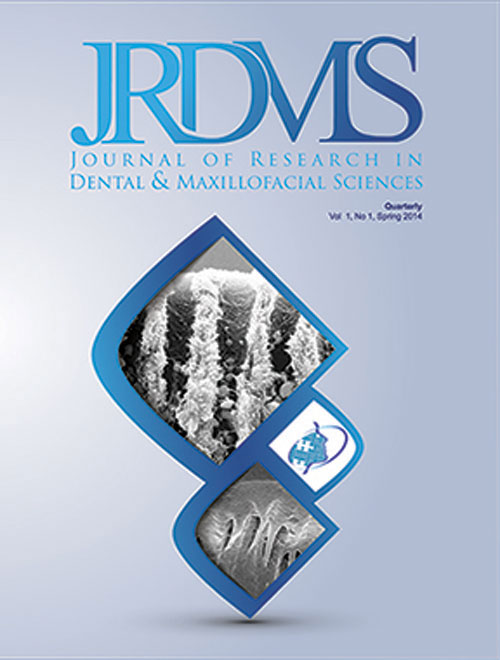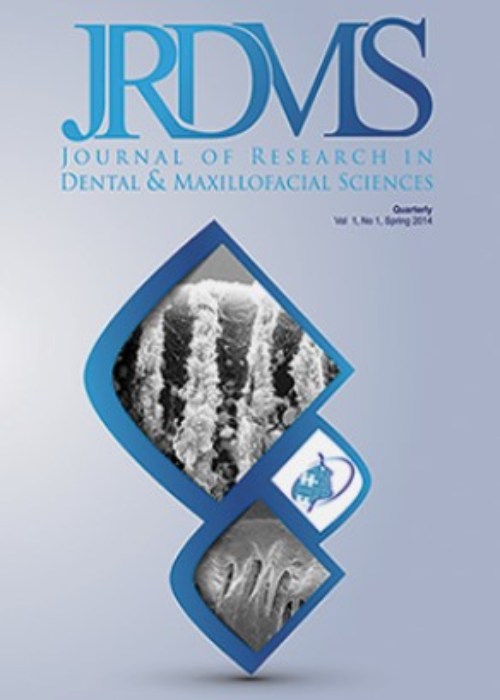فهرست مطالب

Journal of Research in Dental and Maxillofacial Sciences
Volume:4 Issue: 4, Autumn 2019
- تاریخ انتشار: 1398/07/24
- تعداد عناوین: 7
-
Pages 1-5Background and Aim
Reducing the number of pathogenic microorganisms can contribute to reducing the incidence and epidemiology of periodontal diseases. This study aimed to evaluate the clinical effects of Ardox-X active oxygen-containing toothpaste on periodontal indices in patients with at least 1 to 2 implants.
Materials and MethodsIn this crossover randomized clinical trial, 30 subjects were randomly divided into two groups (n=15). Oral hygiene instructions were delivered to all subjects before the study. Scaling and root planing (SRP) were performed for all subjects. The subjects were instructed to brush with Oral-B toothpaste and toothbrush twice daily for at least two minutes. All subjects returned 10 days later, and the plaque index (PI) and gingival bleeding index (GBI) were measured. The first group received Ardox-X, and the second group received Oral-B toothpaste. Both groups presented after 7 days, and GBI and PI were measured. SRP was performed again, and the plaque was zeroed. Both groups spent the wash-out period for 10 days. Next, the indices were measured again. The Ardox-X group received Oral-B toothpaste and vice versa. After 7 days, both groups returned, and the indices were measured again. T-test was used for statistical analysis.
ResultsNo significant difference was observed in the PI changes between the control (0.88±0.22%) and case (0.83±0.22%) groups (P<0.6). The changes in the GBI were significantly different between the control (3.9±3.4%) and case (1.5±2%) groups (P<0.01).
ConclusionThe results of this study showed that Ardox-X toothpaste performs better than the control group (Oral-B) in terms of the GBI.
Keywords: Active Oxygen, Toothpastes, Dental Implants, Periodontal Indices, Gingival Bleeding on Probing, Dental Plaque Index -
Pages 6-10Background and Aim
One of the important characteristics of nickel-titanium (Ni-Ti) rotary files is their dentin removal ability. The purpose of this study was to compare One Shape and F6 SkyTaper files in terms of dentin removal from the mesiobuccal canals of extracted first mandibular molars.
Materials and MethodsIn this experimental study, 24 mesiobuccal canals of extracted first mandibular molars were selected. After preparing an access cavity, the samples were divided into two groups (n=12). The samples were air-dried and incubated for 8 hours at 82°C for moisture removal. The initial weight of the specimens was then measured. The samples in group A were prepared using One Shape (#25/0.06) files while the samples in group B were prepared using F6 SkyTaper (#25/0.06) files at a speed of 400 revolutions per minute (rpm) and torque of 2.2 N/cm for 10 seconds. The samples were again rinsed, dried, and incubated to eliminate moisture. The weights of the teeth were measured after preparation to compare the dentin removal efficacy. The results were analyzed using paired t-test (P<0.05).
ResultsThe mean weight of the removed dentin was 0.053±0.019 g in the SkyTaper F6 group and 0.045±0.073 g in the One Shape group, which was 0.008 g or 15% less in the One Shape group, but the difference was not statistically significant (P=0.6).
ConclusionThe amount of the dentin removed from the root canals by the SkyTaper F6 rotary system was greater compared to the One Shape rotary system although the difference was not statistically significant.
Keywords: Dentin, Endodontics, Equipment Design, Root Canal Preparations, Nickel, Titanium -
Pages 11-16Background and Aim
The ability to predict the final result of the facial profile has a major rule in treatment planning since the main objective of most patients for orthognathic surgeries is to improve their overall aesthetics. On the other hand, treatment planning for borderline patients is more difficult and challenging. Sometimes, we have to consider all the aspects of the dentofacial profile and choose the best treatment plan. This study aimed to evaluate and compare different treatment plans proposed by oral and maxillofacial surgeons and orthodontists for inclined Class III patients.
Materials and MethodsThis review has been done by searching the English articles published between 1998 and 2019 in the PubMed and Google Scholar databases using the following keywords: Clinical Protocols, Malocclusion, Angle Class III, Surgeons, and Orthodontists.
ConclusionThe comparison of the treatment plans between orthodontists and maxillofacial surgeons for inclined Class III patients showed no significant differences. The patients reached optimal function and aesthetics with both treatment plans.
Keywords: Clinical Protocols, Malocclusion, Angle Class III, Surgeons, Orthodontists -
Pages 17-22Background and Aim
Oral hygiene is important against the development of chronic periodontitis. There are concerns about bacterial resistance to antibiotics. The current study aimed to determine the antimicrobial activity of aqueous garlic extract (Allium sativum) against Porphyromonas gingivalis (P. gingivalis).
Materials and MethodsAqueous garlic extract was prepared, and the inhibitory effect of the extract was tested against P. gingivalis. The minimum inhibitory concentration (MIC) and the minimum bactericidal concentration (MBC) against the control group (0.2% chlorhexidine) were also determined.
ResultsSignificant differences were observed concerning the MIC (1.21±0.37 µl) and MBC (1.44±0.67 µl) against P. gingivalis between the aqueous garlic extract and control groups (0.29±0.1 µl; P<0.001). There was a significant difference in the inhibitory zone against P. gingivalis between the aqueous garlic extract group (20.1±1.4 mm) and the control group (27.3±1.8 mm); the inhibitory zone was larger in the control group (P<0.000).
ConclusionThe results suggested that although chlorhexidine exhibited better antimicrobial activity against P. gingivalis, the aqueous garlic extract also showed acceptable results. Further research using different extraction methods and concentrations is suggested.
Keywords: Microbial Sensitivity Tests, Plant Extracts, Garlic, Porphyromonas gingivalis -
Pages 23-27Background and Aim
One of the main goals in the fabrication of an implant-supported prosthesis is to build a superstructure with passive fitness. If this fails, it will lead to the failure of the implant components. This study aimed to investigate the effect of Duralay and Pattern Resin splinting materials on dimensional accuracy in the open tray impression technique.
Materials and MethodsAn edentulous acrylic model was developed. In the lateral teeth area, two implants (CMI, Neobiotech Co.) were placed perpendicularly and parallel to each other. The implants were cemented with cyanoacrylate. Pattern Resin (n=10) and Duralay (n=10) were used to splint the impression copings, and the impression was taken using the open tray technique. The main casts (20 pieces) were made with Vel-Mix type IV plaster using a vacuum mixer. The dimensional changes of each group were measured using a multi-axial coordinator. T-test was used to analyze the data.
ResultsThe mean dimensional changes of implant position transfer at the x-axis were 5.04±0.37 μm for Duralay and 5.58±0.13 μm for Pattern Resin. The mean dimensional changes of implant position transfer at the y-axis were 7.01±0.49 µm for Duralay and 6.78±0.15 µm for Pattern Resin. The mean dimensional changes of implant position transfer at the z-axis were 7.62±0.71 µm for Duralay and 6.86±0.12 µm for Pattern Resin. T-test showed that the difference between the two groups was not statistically significant (P>0.05).
ConclusionAccording to the results, Duralay and Pattern Resin were not significantly different regarding dimensional changes in the open tray impression technique.
Keywords: Dental Implant, Dental Impression Technique, Splints, Acrylic Resins -
Effective Factors in Implant System Selection by Dentists in Kerman in 2018: A Cross-Sectional StudyPages 28-42Background and Aim
Since different implant systems are available, dentists are confronted with the question of which criteria are essential for a proficient implant system selection. This study aimed to investigate the factors affecting implant system selection by dentists in Kerman.
Materials and MethodsA questionnaire inspecting the key factors in implant system selection was distributed among 120 dentists. Fisher's exact test was used to analyze the data.
ResultsMost dentists used two implant systems at the office (52.5%). For the majority of dentists (40.8%), the first factor in choosing an implant system was the implant support services. The price of each implant (25.8%) and the satisfaction of previous cases (23.3%) were the second and third factors, respectively. For most dentists (59.2%), the least important reason for choosing an implant system was the manufacturing country. Recommendation from colleagues (24.2%) was of minor importance in implant system selection. Sixty-one (50.8%) dentists had a history of abandoning an implant system because of failure (59.0%) and lack of support from the importer (27.9%). The quality of the implant was the major cause of system selection for 68.8% of dentists and 75% of specialists (P<0.05).
ConclusionThe most important reason for choosing an implant system was post-sales services. The cost of each implant and the satisfaction of previous cases were other important factors. The least important factor was the system's manufacturer.
Keywords: Dentists, Dental Implants, Dental Implantation -
Pages 43-48Background
Keratocystic odontogenic tumors (KOT) have a high rate of recurrence, which is higher in patients diagnosed with Gorlin-Goltz syndrome (GGS). Adjunctive therapies, such as fixative chemical solutions, decrease the rate of recurrence after enucleation and peripheral ostectomy but have high morbidity rates. Topical 5-Fluorouracil (5-FU) has been suggested as a new therapy that provides a directed molecular approach to treatment.
Case PresentationThis is a case report of GGS treated using topical 5-FU as an adjunctive material after enucleation and peripheral ostectomy. New bone formation sites were identified in the radiographic follow-up. The patient was followed up for 10 months regularly without any evidence of recurrence.
Conclusion5-FlU is an effective and novel targeted treatment for KOTs. Topical application of 5-FU, following enucleation and peripheral ostectomy, effectively treats syndromic KOTs, resulting in normal bony healing with no adverse local or systemic effects.
Keywords: Odontogenic Tumors, Basal Cell Nevus Syndrome, Recurrence, 5-fluorouracil, salicylic acid drug combination [Supplementary Concept]


